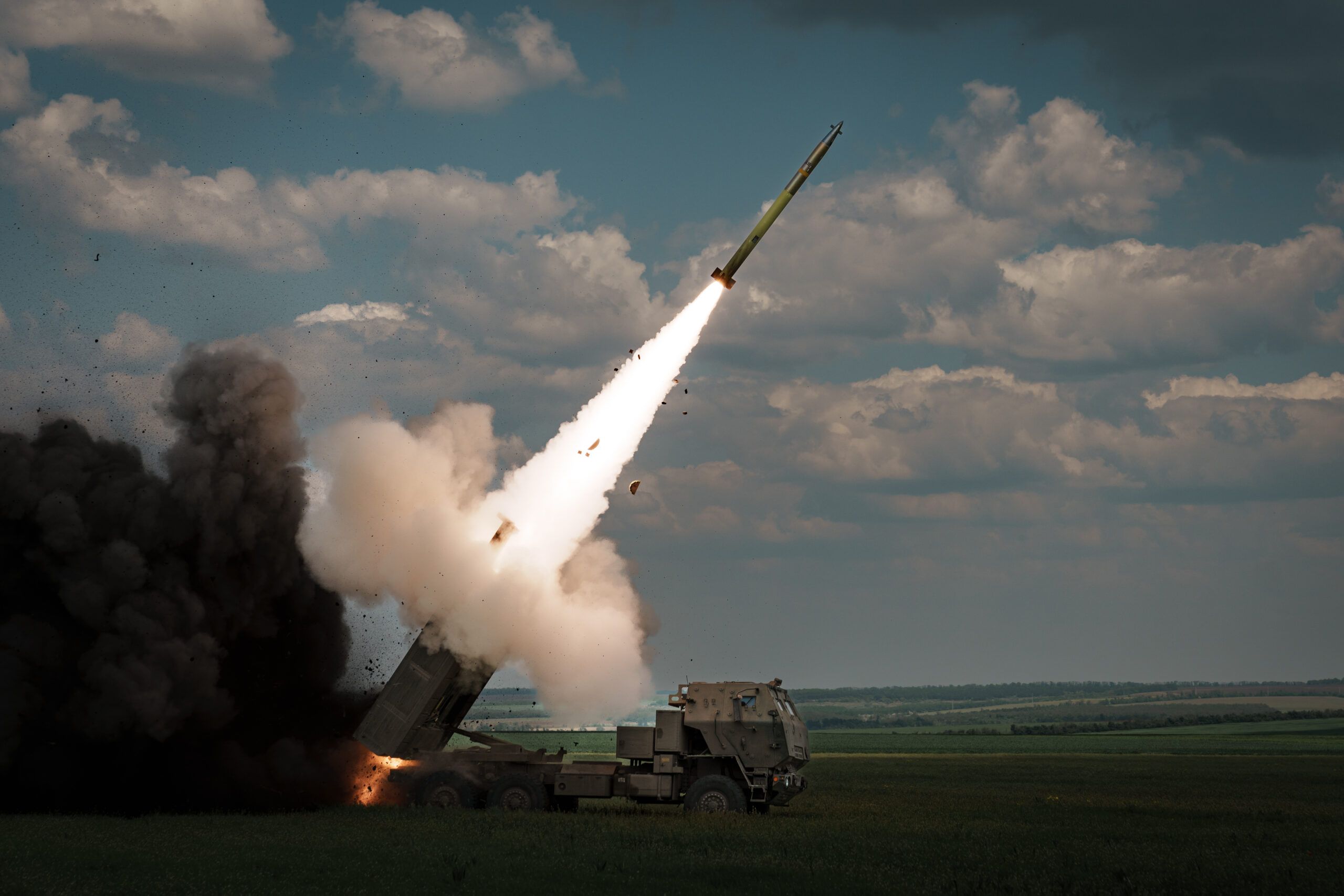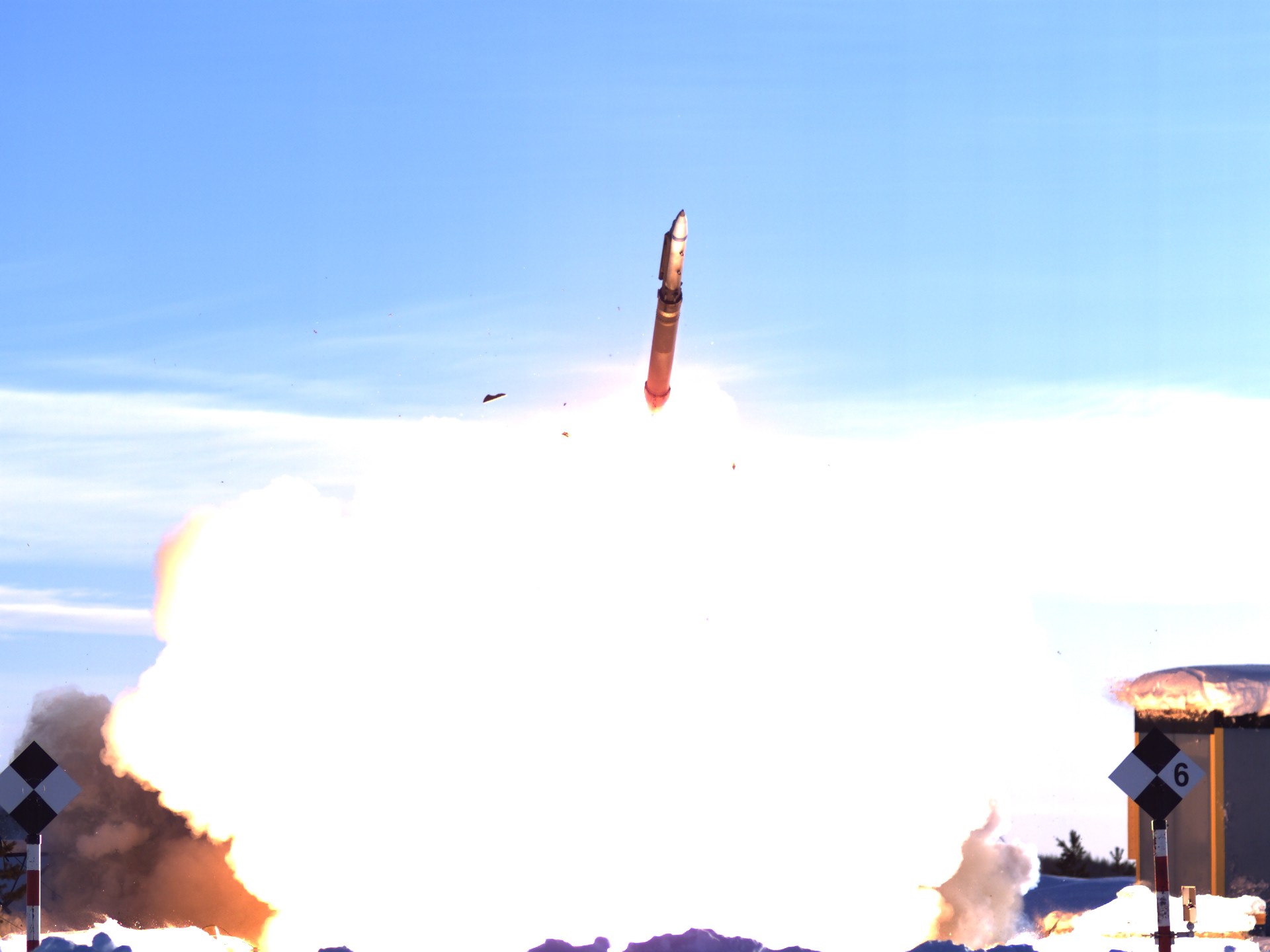The Ground Based Small Diameter Bomb (GLSDB), promised to Ukraine last February, could arrive on the battlefield as soon as Wednesday, Politico reported on Tuesday.
The U.S. Army oversaw the testing of the new precision-guided weapon before providing its stamp of approval to send it to Ukraine, an industry source told the publication.
The GLSDB has a range of around 94 miles. That’s nearly twice the 50-mile range of the Guided Multiple Launch Rocket Systems (GMLRS) munitions fired by the M142 High Mobility Artillery Rocket Systems, or HIMARS and the M270 Multiple Launch Rocket System (MLRS) provided to Ukraine.
As we have previously reported, the GLSDB was developed by Boeing in partnership with Saab of Sweden. Each bomb is a combination of two existing systems, the air-launched 250-pound GBU-39/B SDB with its pop-out wing set and the rocket booster motor from the 227mm-caliber M26 artillery rocket. That’s among the munitions that can be fired by HIMARS and its tracked stablemate, the M270.


Propelled by the M26 rocket motor for the initial boost/loft phase, the GLSDB’s wings are then deployed and it flies unpowered, as a glide bomb. It uses the GBU-39/B’s existing inertial navigation system and embedded GPS to guide it to its target. That guidance system not only ensures accuracy to within three feet, according to Saab, but is also resilient to electronic warfare jamming, something that is of particular concern in the Ukrainian conflict.

Another selling point for the GLSDB is that M26 rockets and the GBU-39/B SDB are widely available in the stockpiles of the United States and other allies. That’s especially important given that the flow of arms from Washington to Kyiv has dried up as a $111 billion supplemental aid package introduced by the Biden administration has yet to be approved by Congress.
Despite the fact that the U.S. has no new money to authorize weapons transfers from existing stocks, the U.S. signed a contract with Boeing last year to provide the weapon to Ukraine, Politico reported. The GLSDB does not currently exist in U.S. stocks.
As we previously reported, the delivery of GLSDBs to Ukraine was initially slated for the fall of 2023 but was delayed. In November, people familiar with timing said delivery to the U.S. by Boeing would take place in late December, according to Reuters. After that, the Pentagon needed several months of testing before the weapons are sent to Ukraine.
At the time, a Pentagon spokesman told Reuters that “we anticipate providing this key capability in the early 2024 timeframe after successful verification,” another term for testing.
Because the contract to begin production of GLSDB was signed in March, according to a Pentagon statement to Reuters, delivery was forced towards year-end. Production required government-furnished materials, so contract signing constrained its start.
The overall cost of the GLSDB is lower than a GMLRS. A single GBU-39/B is priced at around $50,000. In contrast, a GMLRS round costs approximately $100,000.

Given that this is a new system, having it used by Ukraine is a win for Boeing and Saab as well if it shows success on the battlefield.
Air Force Maj. Gen. Pat Ryder, the Pentagon’s spokesman, declined to confirm the Politico report or provide specifics about the delivery dates.
“Due to operational security reasons, we’re not going to confirm specific timelines,” he told The War Zone, adding that he defers to Ukraine to talk about the delivery schedule.

It is unknown how many GLSDB systems will be provided to Ukraine, but any amount of another long-range weapon will certainly prove beneficial. French donated SCALP-EGs and U.K. provided Storm Shadow air-launched cruise missiles have been used to significant effect far behind the front lines, especially on targets in Crimea, as we have written about frequently.
While the GLSDB won’t have the reach of the of either of those cruise missiles, nor anywhere near the punch, it has the advantage of not requiring an aircraft like an Su-24 Fencer to launch, which are under increasing threat the closer they get to the front lines. Ukraine also has its locally made long-range Neptune cruise missile, that is also now capable of attacking targets on land.
While ATACMS ballistic missiles have been supplied in very small numbers to Ukraine, these earlier variants have similar range as GLSDB, but GLSDB doesn’t have nearly the wide area destructive capability as cluster munitions-equipped ATACMS. There have been signs that longer-range ATACMS could be provided, but no confirmation of that occurring yet.

While long-range one-way attack drones can also hit targets with relative precision over distance, they cannot do so as reliably or with the same punch as the SDB, which features a small but very powerful warhead capable of penetrating fortified structures.
So, GLSDB would fill in a highly relevant, flexible, and reliable standoff strike strike capability that falls between M31 guided rockets fired by HIMARS and cruise missiles.
Given the ubiquity of imagery emerging from the battlefield, especially munitions, it likely won’t be long before we learn that the GLSDB has been actually been used by Ukraine. We will provide additional details when and if that happens.
Before diving into more developments from the conflict in Ukraine, The War Zone readers can review our previous coverage here.
The Latest
On the battlefield, little has changed in the last 24 hours, though the Russians continue to make gains near Kreminna and Avdiivka and in the Donetsk-Zaporizhia Oblast border area, according to the latest assessment from the Institute for the Study of War.
Rampant speculation over the future of Ukraine’s top military commander has roiled the force at a precarious time.
Ukrainian President Volodymyr Zelensky offered Valeriy Zaluzhny, commander-in-chief of the armed forces, a new role as a defense adviser on Monday, but the general refused, four people familiar with the discussions told Financial Times.
Some Ukrainian media speculated that Zaluzhny would be replaced by Lt. Gen. Kyrylo Budanov, the commander of the Defense Intelligence Directorate (GUR). On Tuesday, however, Budanov told us there was no information on that possibility.
“I am in my office and no one showed me any order,” he told us on Monday. Asked if he anticipated that change to occur, Budanov said, “I don’t know.”

The U.S. Defense Department has not been informed of any change in Ukraine’s command, Air Force Maj. Gen. Pat Ryder, the Pentagon’s top spokesman, told The War Zone Tuesday.
There have been simmering tensions between Zelensky and Zaluzhny, a widely popular figure in Ukraine widely considered as a potential political rival in the future.
As Financial Times noted, the strain in their relationship boiled over into the public eye after Zaluzhny said the much-hyped counteroffensive designed to take back lost territory and cut off the land bridge to Crimea had reached a stalemate.
Though Zaluzhny was still in his post as of Tuesday, the controversy is taking a toll on the troops.
“Zaluzhny enjoys very high authority in the army,” Lt. Pavlo Velychko, who is serving in Ukraine’s 101st Territorial Defense Brigade, told The New York Times. Firing the general, he said, would be “a signal to commanders of all ranks: No matter how well you do your job, you can be removed without reason.”
Speaking of Budanov and Avdiivka, the Ukrainian spy boss said that he expects the Russian offensive on that beleaguered Donetsk Oblast city will sputter out.
“(Russia’s) offensive is still ongoing. Somewhere in early spring, it will be exhausted completely,” Budanov said on national TV.
Budanov played down the Russian forces’ gains, saying they had only achieved “a few advances across some fields” and near the embattled town of Avdiivka. “Now it’s the enemy’s move. It will end, and I think ours will start,” he added.
Another Russian Su-34 Fullback fighter-bomber was shot down by Ukrainian air defenses in the Luhansk region on Tuesday, the Ukrainian Armed Forces General Staff said on its Facebook page. The General Staff provided no further details about exactly where or how the jet was shot down.
As of 7:30 PM Eastern time, the Russian Defense Ministry had yet to address the loss of a Fullback. While The War Zone cannot independently verify this claim, we have written in the past about a number of cases where Su-34s have either been shot down or destroyed on the ground.
There have been at least 24 Su-34s destroyed during the full-on war in Ukraine, according to the Oryx open source tracking group. That figure could be higher because Oryx only tabulates losses based on visual confirmation.
Speaking of Su-34 Fullbacks, Russia released a video offering a closer look of a UMPK, or Unifitsirovannyi Modul Planirovaniya i Korrektsii, meaning unified gliding and correction module-equipped FAB-500M-62 bomb under the wing of one of those strike jets.
There may be a deal in the works to transfer scores of M-84AB tanks from Kuwait to Ukraine through Croatia, according to a Serbian news outlet.
Kuwaiti officials “are considering the possibility of sending the existing more than 100 M-84AB tanks to Croatia for overhaul and modernization at the facility of the local engineering holding Đuro Đaković in the city of Slavonski Brod, and in connection with their subsequent transfer to Ukraine,” the Serbian TV Front news outlet reported.
The M-84 tanks are derivatives of the Soviet T-72M that were made in the former Yugoslavia.
“The Kuwaiti army does not need these tanks (they are in storage) because it has 218 American-made M1A2 Abrams tanks, but the previous ruler did not want to interfere even indirectly in the Ukrainian conflict,” TV Front reported.
The Russians, meanwhile, continue to manufacture weapons. Defense Minister Sergei Shoigu got a chance to see the production of M14 Kalibr land attack cruise missiles (LACM) and 9K720 Iskander-M short-range ballistic missiles at the Almaz-Antey plan in Yekaterinburg. Shoigu also inspected the assembly of S-300V and Buk air defense systems at the Kalinin machine-building plant.
In the age of drones, mid-air duels are becoming more prevalent, like this one between Russian Autel drones sent up to ram Ukraine’s large Baba Yaga drones.
In the first engagement, there was a collision, destroying both, according to the Russian milblogger who provided the video. In the second, the Baba Yaga remain unscathed.
And finally, Ukrainian troops do love their combat kittens.
That’s it for now. We’ll write more about Ukraine when there’s more news to report.
Contact the author: howard@thewarzone.com
